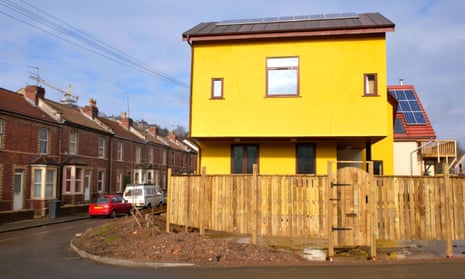Homebuyers could take out bigger mortgages if the energy ratings of properties were factored into the lending criteria of banks and building societies, government-funded research has found.
Although estate agents are legally bound to display energy performance certificates (EPCs) in property listings, few buying decisions hinge on energy bill costs and the efficiency of a home is not considered in affordability calculations by lenders.
However, if the A-G rating of the EPC was part of the calculation it would allow people to borrow £4,000 more in many cases and up to £11,500 in extreme ones, according to analysis by the Nationwide Building Society, Arup and building groups.
Even if buyers did not borrow the extra money, they would be attracted by the “perception of value” implied by the higher limits, the research said. Well-insulated homes would eventually sell more quickly and command a modest price premium.
The idea is the latest in a string of mooted incentives to encourage people to insulate their homes and nudge buyers towards greener properties, such as a discount on stamp duty for energy efficient homes.
Experts said the proposal could be a “major driver” in linking energy performance to house prices, and ministers called the work a “timely and valuable contribution”.
Richard Twinn, a policy adviser at the UK Green Building Council, said: “This new research shows that if lenders use information about a property’s energy performance when making lending decisions, this could encourage homebuyers to choose more efficient homes by increasing the size of mortgage available for these properties.”
The report by the Lenders group, which includes the Principality Building Society and UCL Energy Institute, examined data from about 40,000 properties to model how much different EPCs would free up expenditure on energy for a bigger mortgage instead.
Most mortgage lenders today use Office for National Statistics data on energy bills, based on a smaller dataset of properties, and sometimes also obtain data from customers on their actual spending on gas and electricity.
But the figures do not reflect the efficiency of the property being bought and so as the report notes: “past fuel bills may well not represent future fuel bills”.
The difference between an A- and G-rated home would be as much as £11,500 in extra borrowing, the analysis found, falling to about £4,000 extra on a mortgage offer between an E- and C-rated property.
The Lenders group said that because energy bills were a sizeable part of borrowers’ essential expenditure, it was a component of the affordability calculation that warranted being made more sophisticated.
However, it admitted that incorporating the changes would not be straightforward due to the complexity of lenders’ systems.
Making the proposal a reality would provide a major boost for the insulation and building industry.
Since 2015 when the government axed the green deal, its flagship energy efficiency policy, there have been no incentives for the so-called able-to-pay market despite the UK having some of the least efficient homes in Europe.
During the general election campaign, the energy industry called for the next government to make energy efficiency a national priority to curb household bills and hit carbon targets.

Comments (…)
Sign in or create your Guardian account to join the discussion